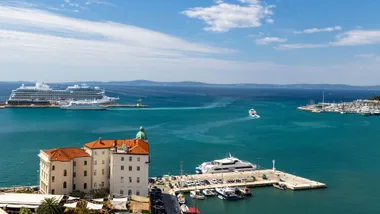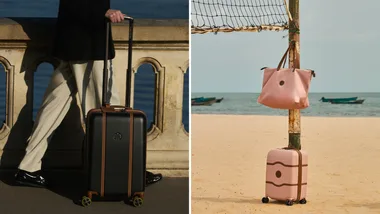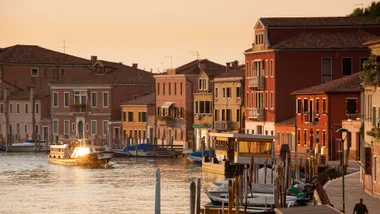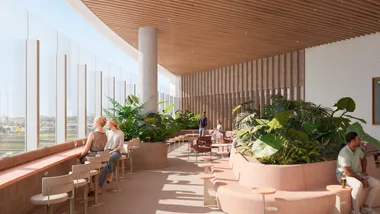GETTING THERE
Haneda Airport is about 15km from central Tokyo, while Narita is about 65km away. Qantas and ANA fly direct from Sydney to Haneda. Direct flights to Narita are on JAL from Sydney, Qantas from Brisbane, and Jetstar from Melbourne.
GETTING AROUND
Chef Michael Ryan, of acclaimed restaurant Provenance in Victoria’s Beechworth, hosts two-week tours to Tokyo with Epicurious Travel. epicurioustravel.com.au
STAY
Aman Tokyo
Opened in 2014, the luxe resort group’s first urban hotel was designed by Australian architect Kerry Hill along the lines of traditional Japanese homes: lots of timber, washi paper and beautiful pottery. Its restaurant is definitely worth visiting. Rooms from $1,300. 1-5-6 Otemachi, Chiyoda-ku, +813 5224 3333, aman.com
Andaz Tokyo Toranomon Hills
More boutique than big-city hotel. Rooms from $600. 1-23-4, Toranomon, Minato-ku, +813 6830 1234, tokyo.andaz.hyatt.com
Park Hyatt Tokyo
The understated styling here evokes the house of a friend (with money and taste to burn); the lobby is lined with 2,000 books on walnut shelves. Rooms from $630.3-7-1-2 Nishi Shinjuku, Shinjuku-Ku, +813 5322 1234, tokyo.park.hyatt.com
EAT & DRINK
Aria di Tacubo
Bios Bldg. 4F 1-12-11 Ebisu-Nishi, Shibuya-ku, +813 3496 5050, tacubo.com
Bar High Five
Efflore Ginza5 Bldg. BF 5-4-15 Ginza Chuo-ku, +813 3571 5815, barhighfive.com
Bar Tender
6 Chome-5-15 Ginza, Chuo, +813 3571 8343
Café de L’Ambre
8-10-15 Ginza, Chuo-ku, +813 3571 1551, www.h6.dion.ne.jp/~lambre
Craftale
2F 1-16-11 Aobadai, Meguro-ku, +813 6277 5813, tables.jp.net/craftale
EbisuYokocho
1-7-2 Ebisu, Shibuya
Florilege
Seizan Gaienmae B1F, 2-5-4 Jingumae, Shibuya-ku, +813 6440 0878, aoyama-florilege.jp
Fuunji Tokyo
2-14-3 Yoyogi, Shibuya-ku, +813 6413 8480
Gen Yamamoto
1-6-4 Azabu-Juban, Minato-ku, +813 6434 0652, genyamamoto.jp
Iguchi
Highness Nakameguro 109, 1-2-9 Kamimeguro, Meguro-ku, +813 6451 0575
Jimbocho Den
2-2-32 Jinbocho, Kanda, Chiyodaku, +813 3222 3978, jimbochoden.com
L’Effervescence
2-26-4 Nishi-Azabu, Minato-ku, +813 5766 9500, leffervescence.jp
Narukiyo
B1F, 2-7-14 Shibuya, Shibuya-ku, +813 5485 2223
Sanda
4-5-9 Roppongi, Minato-ku, +813 3423 2020, sanda.tokyo
Sushitake Ginza
7-6-5 Ginza, Chuo, +813 6228 5007
Sushi Tokami
Ginza Seiwa Silver Bldg, 8-2-10 Ginza, Chuo-ku, +813 3571 6005, sushitokami.3zoku.com
Torishiki
2-14-12 Kami- Osaki, Shinagawa-ku, +813 3440 7656
World Breakfast All Day
3-1-23 Jingumae, Shibuyaku, +813 3401 0815, world-breakfast-allday.com
Yakumo Saryo
3-4-7 Yakumo, Meguro-ku, +813 5731 1620, yakumosaryo.jp
I travel to Tokyo frequently, but I’m always slightly overwhelmed when I arrive at Shinjuku Station via the Narita Express train. With more than three million people passing through the station’s 200-plus entrances each day, my reaction is perhaps understandable. At any time of day, Shinjuku is pumping, though the crowd varies. Early morning and late afternoon is the worker crush, lunch has a slightly less purposeful feel, while late at night there’s a party waiting to happen or winding up.
The first thing to realise is that you haven’t arrived in the heart of a city, but at a conglomeration of cities, each with its own character. Shinjuku: neon, a certain seediness in parts, and some wonderful department stores. Harajuku: youth culture and Yoyogi Park. Ginza: home of international brands and all the shopping you could ever need. Omotesando: boutique clothing stores. Daikanyama and Nakameguro for small, unique design shops. Koenji: Tokyo’s new home of all that’s cool. And that’s just the start.
Then there’s the food. Wherever you are in Tokyo, you’ll be able to find somewhere special to eat: ramen shops for ten-dollar bowls of noodles, to mid-range izakaya, to big-ticket establishments. Don’t believe the oft-quoted myth that it’s hard to find a bad meal – they’re certainly out there – but with due diligence they’re easy to avoid.

Asa-cha breakfast of rice porridge with side dishes and tea at Yakumo Saryo.
The sheer number of restaurants and the variety of styles can be daunting. Where to start? Most restaurants in Japan specialise, often narrowly. Their goal is to focus on a particular dish and elevate it to perfection. That could be sushi, yakiniku (a style of grill-your-own meats at the table, borrowed from Korea), ramen, udon (the Japanese traditional thick wheat noodle), soba (a buckwheat noodle; Minatoya standing bar is a favourite), gyoza (Harajuku Gyoza Lou is a standout), unagi and anago (fresh water and sea eel, respectively; Tamai is my choice for the latter), izakaya (Japan’s version of a pub, with considerably better food), yakitori (chicken morsels on sticks grilled over charcoal), tonkatsu (fried breaded pork cutlet; best at Butagumi), tempura (how can a meal of fried food be so light and fresh?) or kaiseki (the traditional, formal, multi-course meal focusing on the seasons). Then there are the non-traditional restaurants specialising in the cuisine of any country you might be interested in, and some of the finest international restaurants I’ve visited.
I always have sushi when in Tokyo, and the old you-get-what-you-pay-for adage rings particularly true here. Once you get to the pointy end of sushi establishments, however, the differences become quite esoteric. It’s not just about the small morsel of fish and rice in front of you – it’s about the choreography of the chef, the timing, and the almost reverential atmosphere. This is not how the Japanese eat sushi every day, of course, even if they did eat sushi every day. Sushi as an art form can be experienced at restaurants such as Sushi Saito, Sushi Sho Masa, Miyakozushi, Sawada, Sukiyabashi Jiro – I could go on. They are expensive and notoriously difficult to book, but you will not eat sushi like it anywhere else.
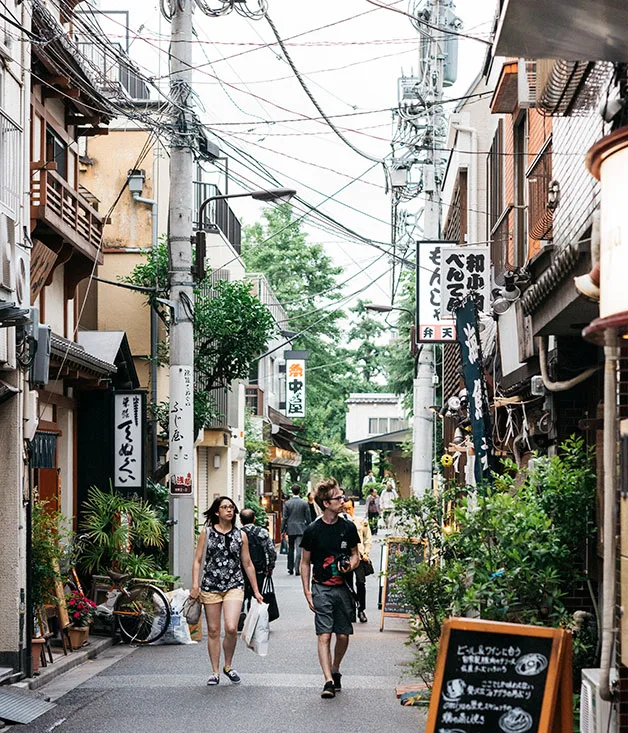
The streets of Tokyo.
It’s said that seasons in Japan are measured more by the availability of certain seafood than vegetables, and this is most evident at restaurants such as Sushi Tokami and Sushitake Ginza, both in Ginza. The latter has a female chef, Fumie Takeuchi, which is unusual in the staunchly patriarchal world of sushi, and she produces wonderful sushi at a moderate price. As with most sushi joints, the room here is simple – dominated by a counter made of hinoki cypress – but Sushitake has a congenial atmosphere that’s sometimes missing. Takeuchi seasons her rice with akazu, a red vinegar made from sake lees, and serves it at body temperature. The rice is not overly acidic and pairs perfectly with her supremely fresh seafood. The meal begins with a plate of mizunasu, a type of eggplant that, served raw, has a crunchy, almost apple-like texture. It’s followed by some interesting sashimi, from abalone to the more texturally challenging torigai, or surf clam, and tsubugai, or whelk. And then the sushi: a dozen or so exquisite pieces.
Sushi Tokami, run by the charming, amiable and English-speaking Hiroyuki Sato, also features rice seasoned with red vinegar, but here it’s more robustly flavoured than at Sushitake Ginza. It works perfectly with some of the best tuna in Japan. Tokami’s tuna hand roll made from the fish’s neck meat is one of the best things I’ve eaten in recent visits to Tokyo.

Café de l’Ambre.
A visit to the wonderful Café de l’Ambre in Ginza is a must. Tokyo’s coffee scene is a mix of the traditional kissaten and the new espresso joints – Café de l’Ambre is definitely of the older school. Opened in 1948, its coffee is produced via drip method and the specialty of the house is aged coffee, some dating back 50 years, kept as green beans and roasted as needed.
Another place I visit every time I’m in Tokyo is Jimbocho Den. Run by husband-and-wife team Zaiyu and Emi Hasegawa, it does kaiseki but with a modern, quirky approach. Fun is not normally a word associated with kaiseki, but the team’s sense of playfulness, with a touch of kawaii (a Japanese term for cuteness), makes for a unique dining experience. Zaiyu’s technique is exact, his flavours exquisite. His sea urchin dish is like no other I’ve tasted, juxtaposing fresh and grilled urchin with dried wakame to crumble over the top, plus fresh wasabi and umi budo, or sea grapes. The little message in a bottle next to the dish welcoming me back to Den is classic Zaiyu. His produce – raw turnips as juicy as peaches, tomatoes like I’ve never tasted before – never fails to make me profoundly jealous.
.jpg?resize=877%2C1024)
Zaiyu Hasegawa of Jimbocho Den.
Hiroyasu Kawate, of Florilege in Aoyama, is a compatriot of Zaiyu’s. Though Kawate’s food comes from a different angle, it has that same originality, creativity and precision. It’s French, but the kind that could only come from Tokyo. The room’s dark tones, with a sunken kitchen surrounded on three sides by a solid, metallic bar, matches the drama of the food. Carpaccio from 10-year-old beef, with smoked potato purée and a plum consommé poured at the table, is sweet, salty, earthy. Pigeon from Ibaraki, with a sauce of its offal and a brown-rice risotto is seemingly simple, but has real depth. A dessert of frozen mozzarella, salted meringue, basil and lemon sits cleverly on the border between savoury and sweet.

Florilege for French cuisine.
Another young chef creating a buzz is Shinya Otsuchihashi at the newly opened Craftale. He creates contemporary, creative and beautifully plated food in an elegant dining room on the banks of the Meguro River in cosmopolitan Nakameguro. This is a restaurant to watch.
I’m a repeat customer at L’Effervescence in Nishi-Azabu. Chef Shinobu Namae worked under Michel Bras in Hokkaido and Heston Blumenthal at The Fat Duck, and returned to Tokyo in 2009 to open L’Effervescence. His food is clever, inventive, respectful of Japanese produce and, most importantly, so very tasty.
Japanese cooks are masters of nose-to-tail (and nose-to-fin) eating. It’s not a trend or culinary brinkmanship, just another feature of the cuisine. Sanda focuses on all things in the realm of beef offal. This specialisation may seem challenging – certainly, a trio of cold appetisers of tripe, tendon and artery can be a little daunting to begin with – but the flavours are clean and fresh, and the whole meal has a real lightness. At the end, when you’ve eaten lung, tongue, diaphragm (a particularly delicious muscle), uterus and more, it isn’t a sense of achievement that kicks in but the euphoric, contented feeling you get at the end of a very good meal.
Perhaps my favourite places to eat in Tokyo, though, are izakayas. The term encompasses a range of styles, from rowdy, smoky, grimy joints to more refined, stylish places. They’re all as much about drinking as eating – my kind of places – and tend to offer a wide range of dishes rather than specialise. Narukiyo in Shibuya was recommended to me years ago by Simon Denton, the proprietor of Izakaya Den and Kappo in Melbourne. It’s pretty much all you could want in an izakaya: great produce and booze (especially the shochu), friendly service, and a chef who concocts some amazing dishes in a cramped cooking space. The music spans reggae to rockabilly, the décor includes collections of old music posters and random trinkets. Last time I visited was matsutake season, the most prized of all mushrooms in Japan. The chef grilled them over charcoal, then placed them in a lidded wooden box lined with bracken to steam in their own heat for five minutes. The result was textural, resiny, and novel.
It’s possible to organise your dining itinerary so everything is booked in advance, which is essential for some of the city’s more popular restaurants. Or you can wander the streets and take your chances – some of my best dining experiences have been surprises. A prime area for random culinary discoveries is Koenji, one of Tokyo’s more alternative districts and the birthplace of Japan’s punk movement. There are some great little bars and restaurants to the west of the station, under the tracks. Other areas full of surprises are Shimokitazawa, Kichijoji and the walk between Shibuya and Daikanyama.
More unplanned drinking and dining awaits in Tokyo’s yokocho, or alleys. Omoide Yokocho in Shibuya is very atmospheric, Ebisu Yokocho is raucous and hard to leave sober, and Harmonica Yokocho is in the very cool area of Kichijoji.
.jpg?resize=877%2C1024)
Diners at Ebisu Yokocho.
Tokyo has some seriously good (and very serious) cocktail bars. Bar Tender in Ginza is the home of the Tokyo hard shake, a technique developed by the bar’s owner, Kazuo Uyeda. His staff wear white tuxedos and mix exquisite classics. Bar High Five, also in Ginza, has a much more relaxed, gregarious feel, with lots of conversation and great service from the English-speaking staff. Gen Yamamoto staffs his eponymous bar solo and prepares his unique cocktails in sacred silence, presenting each like a work of art. Often new cocktails lack the synergy of the classics, but not Yamamoto-san’s drinks.
For a slightly less intimate cocktail session, some of Tokyo’s high-end hotels have very good bars. The New York Bar at the Park Hyatt Tokyo in Shinjuku is one of my favourite places, and the new rooftop bar at the Andaz Tokyo Toranomon Hills mixes remarkable cocktails in a relaxed, partly outdoor setting.
I suppose you could go to Tokyo and not eat ramen, but I personally can’t imagine it. Fuunji Tokyo in Shinjuku was my most recent choice. There was a lunchtime queue through the restaurant and out the door, but it moved fast via orders on a ticket-vending machine and an efficient kitchen team. Soon I had a plate of tsukemen in front of me, a version of ramen in which the noodles are served separate from the broth, preventing the noodles from overcooking. And what a soup: rich, thick, chicken-based broth with a large scoop of bonito powder on top to mix in. Be aware that a meal at a ramen shop is meant to be a quick affair; there will be 20-plus would-be diners waiting for your seat.
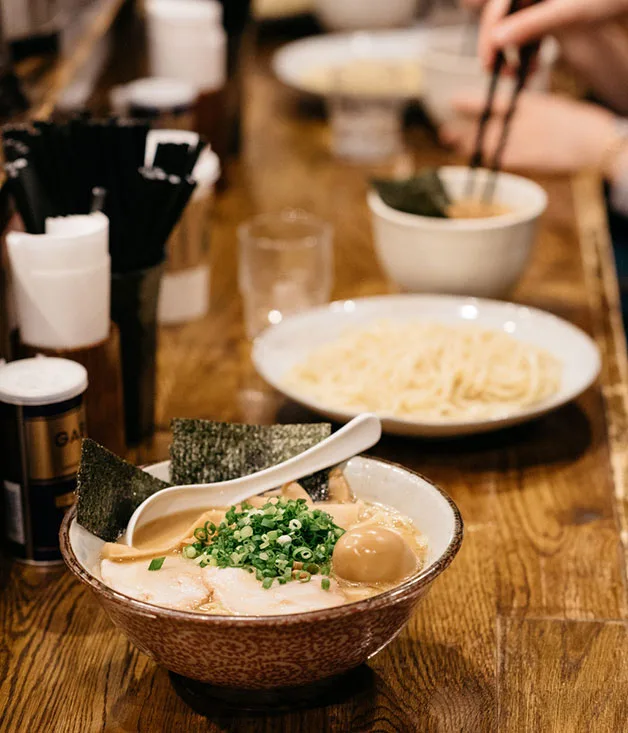
Tsukemen at Fuunji Tokyo.
The polar opposite of a ramen slam-down at lunch is a meal at the slightly out-of-the-way Yakumo Saryo. It needs to be lunch, too; dinner is by invitation only. Set in a grand house in a quiet residential area in the city’s south-west, entry is through a discreetly labelled gate. The interior is minimalist and beautifully designed by renowned Japanese designer Shinichiro Ogata, with large windows overlooking the traditional garden. The food and service match the room – elegant and traditional, with the occasional modern twist.
A stroll through a few depachika, the food halls found in the basement floor of many large department stores, is the best way to grasp the centrality of food to Japanese life. Isetan and Takashimaya in Shinjuku and Mitsukoshi in Ginza are among my favourites. Here you’ll find an enormous array of Japanese goods, from fresh produce and meats to prepared dishes to take home. The selection of Western foods, too, is astonishing – many of the world’s great bakers and pâtissiers have stores in these halls.
One meal you may struggle with is breakfast. Tokyo is a city slow to wake and breakfast isn’t a high priority. World Breakfast All Day, however, is ahead of the curve, with good coffee and, among regular Western morning fare, a monthly rotation of breakfast dishes from around the world.
The ubiquitous yakitori is well represented at every level – smoky, milk-crates-for-seats places to high-end restaurants. As well as the usual beak-to-tail morsels grilled over charcoal, yakitori shops often offer sasami, raw chicken. Though consumption is ill-advised in most parts of the world, raw chicken for these yakitori restaurants is typically raised, butchered and delivered according to strict regulations. It has a texture not dissimilar to raw tuna and, as with a lot of raw meats, is quite mild in flavour, so it’s usually served with ginger and soy. My favourite yakitori place, Torishiki, serves some of the best sasami (chicken tenderloin) I’ve had. Bookings are hellishly difficult to make – plan at least four months ahead. At the more refined end of the yakitori spectrum is Iguchi in Nakameguro. The menu begins with some interesting non-yakitori dishes – a small cup of intensely flavoured fatty chicken broth, perhaps – followed by very good quality skewers.
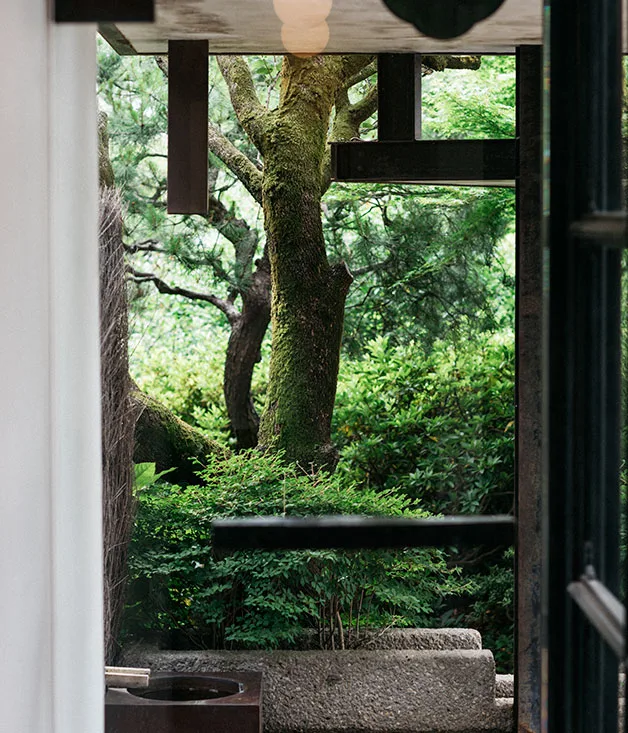
Yakumo Saryo.
Of all the many international cuisines represented here, Italian is the one the Japanese have the most affinity with. My last meal on a recent trip was at a small, beautiful Italian restaurant called Aria di Tacubo, on the fourth floor of a nondescript building in Shibuya (an odd location is a recurring theme in a city where space is so scarce). The food is elegant, light, restrained and exceptionally well cooked, with the depth of umami that makes Italian food so great. This is not theme-park Italian – it has a sense of place, with subtle influences from both the produce of Japan and the technique of Japanese cooking. Think small sweetfish, fried whole, the roe and guts still intact in the Japanese style, with a salad of green tomatoes and cucumber, or fresh orecchiette with mussels, karasumi (pressed dried mullet roe, Japan’s bottarga) and edamame with a light emulsified sauce of the mussel broth.
Quiz anyone who lives in Tokyo or spends a lot of time here and they’ll supply a list of their favourite restaurants and bars as extensive as mine – probably without any double-up. No matter where you end up eating or drinking in Tokyo, the city will deliver something new, something surprising, and perhaps something magical.




